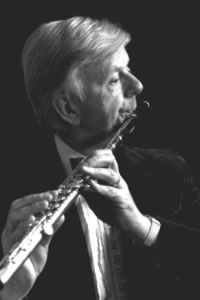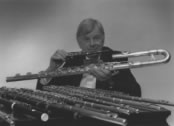| Christopher Hyde-Smith & The Cummings Trio |
Buy this album CD: £10.00 +p&p |
| D MAJOR Kv285 | ||
| 01 | Allegro | 6:45 |
| 02 | Adagio | 2:46 |
| 03 | Rondeau | 4:18 |
| G MAJOR Kv285a | ||
| 04 | Andante | 5:43 |
| 05 | Tempo di Menuetto | 3:20 |
| A MAJOR Kv298 | ||
| 06 | Andante | 6:09 |
| 07 | Menuetto | 2:00 |
| 08 | Rondeau | 3:02 |
| C MAJOR Kv285b | ||
| 09 | Allegro | 5:36 |
| 10 | Thema and Variations | 9:04 |
Sleeve Notes While Mozart was staying in Mannheim during the winter of 1777-8 he was introduced to a wealthy Dutch amateur flautist named 'De Jean' (possibly Dejong, who may have had a position in the Dutch East India Company, since Mozart subsequently referred to him as 'Our Indian'), who commissioned from him 'three short, simple concertos and a couple of quartets' ('3 kleine, leichte, und kurze Concertin und ein Paar quattro auf die flötte'). Mozart behaved rather shabbily over the deal, since although he claimed to have written three quartets, only two (K.285 in D and K.285a in G) can definitely be assigned to his stay in Mannheim, and he only produced two concertos (K.313/285c in G and K.314/285d in D), the second of which was a transcription of an oboe concerto he had composed some months earlier in Salzburg; and he complained bitterly when De Jean only paid him just under half the agreed sum, making excuses for himself in a letter to his father declaring 'you know that I become quite powerless when I am obliged to write for an instrument which I cannot bear': and extraordinary assertion if we consider how intuitively he wrote for it as a solo instrument and in an orchestral context - not least in his last German opera, Die Zauberflöte. The Quartet in D, K.285 (the autograph score of which, inscribed 'Mannheim, 25th December 1777, was formerly in the Prussian State Library in Berlin and is now in the Biblioteka Jagiellonska in Kraków) was, clearly, the first that Mozart wrote for De Jean, and is arguably the best of his four surviving works in this medium. (It begins with a vivacious sonata-form Allegro, which could almost be described as a concerto movement in miniature, if it were not pervaded by such chamber- musical interplay between the four instrumental parts. The elegiac Adagio (in B minor), an instrumental adoso for the flute, accompanied by pizzicato strings is, as Alfred Einstein aptly put it, 'of the sweetest melancholy, perhaps the most beautiful accompanied solo ever written for the flute; it is followed by a spirited Rondeau, notable for the active participation of the stringed instruments, especially the viola.) The Quartet in G, K.285a was probably the second ofthe quartets Mozart wrote for De Jean. Several early editions, beginning with Artaria's of 1792, before the Gesamtausgabe volume of 1882 present its two movements as a pendant to the first movement of K.285 (in D!), and it was first published as a separate piece only in 1938, in an edition by Einstein. The first movement is a pastoral Andante in binary form, the second an elegant Tempo di Menuetto, also in two repeated sections. The Quartet in A, K.298, long believed to date, if not from Mozarfs stay in Mannheim, at the latest from his sojourn in Paris in the spring and summer of 1778, has now been ascribed to his later years in Vienna: to the autumn of 1786 at the earliest. One reason is the handwriting in his autograph score (now in the Austrian National Library in Vienna), another is the fact that this manuscript was formerly in the possession of Baron Gottfried von Jacquin. Mozart played chamber music with Gottfried and his sister Franziska (to whom he dedicated the Trio for piano, clarinet and viola, K.498, dated 5th August 1786) at the house of their father, the eminent botanist Nicolaus Josef von Jacquin, in Vienna, where quatuours d'airs dialogués (ie. based on melodies by other composers) were frequently performed. It has been shown that the theme of the first movement, (a set of variations which give prominence to each instrument in turn (not least the viola: a splendid solo in Variation 3, no doubt originally played by Mozart himself)) is closely related to Hoffmeister's song An die Natur and that the angular Minuet is based on an old French song, Il a des bottes, des bottes Bastien; and that the refrain of the concluding Rondeau is a tune from Paisiello's opera Le gare generose, first seen in Vienna on 1 st September 1786. (The fact that Mozart headed this innocuous finale Allegretto grazioso, mà non troppo presto, però non troppo adagio. Cosi - cosi con molto garbo ed espressione, and that he described it as a Rondieaoux, suggests that the whole affair should not be taken too seriously.) The Quartet in C, K.285b is of questionable authenticity. In the first two editions (1862 and 1905) of Köchel's Thematic Catalogue of Mozart's works it was relegated to Appendix III ('Transcriptions'), because the second of its two movements was thought to be an arrangement of the sixth movement of Mozart's great Serenade in B flat for thirteen wind instruments, K.361/370a (now dated as late as 1784), but Einstein, in the third edition of Köchel's Catalogue (1937), grouped it with the De Jean quartets. The connection with the Serenade is indisputable, but the question as to which version came first has not been satisfactorily resolved. The autograph score has not survived, but a sketch of bars 149-158 of the first movement is found in a notebook which also contains sketches for Die Entführung aus dem Serail, K.384 (1781-2); it seems probable that the quartet dates from the early 1780's and that the second movement was later adapted by Mozart for inclusion in the wind serenade. (The first movement is a lively sonata-form Allegro with a substantial (44-bar) and surprisingly serious development section; the second, so miraculously enriched and transformed in the serenade version, consists of a theme with six variations, the fourth (featuring the viola) in C minor, the fifth marked Adagio, and the sixth Allegro. © Robin Golding 1986 CHRISTOPHER HYDE-SMITH has continued to remain one of the worlds leading flautists since his debut at the Royal Festival Hall in London. He toured Russia with Benjamin Britten and has worked with Casals, Galway, Tortelier, and Stravinsky. There are compositions dedicated to him by Alwyn, Dodgson, Horovitz, Mathias, Metcalf, and Rawsthorne. A recording artist of international acclaim, his future plans include a programme with Jane Dodd (Harpsichord) entitled Bach and his Contempories due to be released by Claudio Records. Since its London debut in 1975, the CUMMINGS STRING TRIO (Diana Cummings - violin, Luciano Iorio - viola, Geoffrey Thomas - cello) has enjoyed enormous success and has established itself as an ensemble of great international standing, with concerts, broadcasts and records highly praised in Europe, the United States of Arnerica and Australia. The Trio has a repertoire of over fifty works, from the 18th century to trios by other distinguished musicians, performing piano, oboe and flute quartets. |
Credits Recorded & Produced:
Colin Attwell
|
| Instruments: | Flute Quartet |
| Genre: | Classical |
| Format: | CD |
| Our Ref: | A0014 |
| MCPS: | CR36103-D |
| Label: | Claudio Records Limited |
| Year: | 1986 |
| Origin: | UK |
Christopher Hyde-Smith
Christopher Hyde-Smith is a professor of flute at the Royal College of Music, where he also studied. He was the founding chairman of the British Flute Society. He plays on a golden flute.
'Never in Munich has a flute player had such a success - and well deserved.' SUDDEUTSCHE ZEITUNG '...... he is among the few [flautists] who are in the finest category.' THE GRAMOPHONE
|
Photographs
by Fritz Curzon |
 These well-loved masterpieces are given superbly stylish performances
by Hyde-Smith & The Cummings Trio. Christopher Hyde-Smith
is a recording artist of international acclaim and has continued
to remain one one the worlds leading flautists since his debut
at the Royal Festival Hall in London. He toured Russia with Benjamin
Britten and has worked with Casals, Galway, Tortelier and Stravinsky.
Since it's London debut in 1975, The Cummings String Trio has
enjoyed enormous success and has established itself as an ensemble
of great international standing, with concerts broadcasts and
records highly praised in Europe, the United States of America
and Australia The Trio has a repertoire of over fifty works,
from the 18th century to trios by other distinguished musicians,
performing piano, oboe and flute quartets.
These well-loved masterpieces are given superbly stylish performances
by Hyde-Smith & The Cummings Trio. Christopher Hyde-Smith
is a recording artist of international acclaim and has continued
to remain one one the worlds leading flautists since his debut
at the Royal Festival Hall in London. He toured Russia with Benjamin
Britten and has worked with Casals, Galway, Tortelier and Stravinsky.
Since it's London debut in 1975, The Cummings String Trio has
enjoyed enormous success and has established itself as an ensemble
of great international standing, with concerts broadcasts and
records highly praised in Europe, the United States of America
and Australia The Trio has a repertoire of over fifty works,
from the 18th century to trios by other distinguished musicians,
performing piano, oboe and flute quartets.
 Christopher
Hyde-Smith's flute playing has been compared in the Guardian
to Sir Lawrence Olivier's acting in variety of expression,
characterization and style. He has played all over the British
isles and at many festivals including Aldeburgh, The Three
Choirs, North Wales and York. He has made many trips abroad
appearing as soloist in France, Germany, the Netherlands, Italy,
Portugal, Scandinavia, Spain and Switzerland as well as North
and South America. He has also visited Russia in an ensemble
directed by Benjamin Britten. Other distinguished musicians
with whom he has performed include Casals, Poulenc, Tortelier
and Stravinsky. Christopher has played the Cimarosa Concerto
for two flutes with james Galway at the Royal Festival Hall
and as concerto soloist he has frequently appeared with the
London Mozart Players and also with the London Symphony, Royal
Philharmonic, Royal Liverpool Philharmonic, BBC Concert, Scottish
and Welsh Orchestras, Philornusica and Northern Sinfonia. Many
composers have written and dedicated works to him, among them
William Alwyn, Stephen Dodgson, Joseph Horowitz, William Matthias,
John Metcalf and Alan Rawsthorne.
Christopher
Hyde-Smith's flute playing has been compared in the Guardian
to Sir Lawrence Olivier's acting in variety of expression,
characterization and style. He has played all over the British
isles and at many festivals including Aldeburgh, The Three
Choirs, North Wales and York. He has made many trips abroad
appearing as soloist in France, Germany, the Netherlands, Italy,
Portugal, Scandinavia, Spain and Switzerland as well as North
and South America. He has also visited Russia in an ensemble
directed by Benjamin Britten. Other distinguished musicians
with whom he has performed include Casals, Poulenc, Tortelier
and Stravinsky. Christopher has played the Cimarosa Concerto
for two flutes with james Galway at the Royal Festival Hall
and as concerto soloist he has frequently appeared with the
London Mozart Players and also with the London Symphony, Royal
Philharmonic, Royal Liverpool Philharmonic, BBC Concert, Scottish
and Welsh Orchestras, Philornusica and Northern Sinfonia. Many
composers have written and dedicated works to him, among them
William Alwyn, Stephen Dodgson, Joseph Horowitz, William Matthias,
John Metcalf and Alan Rawsthorne. 'Christopher
Hyde-Smith is an absolutely first rate flautist...' STEREO
REVIEW, USA
'Christopher
Hyde-Smith is an absolutely first rate flautist...' STEREO
REVIEW, USA


